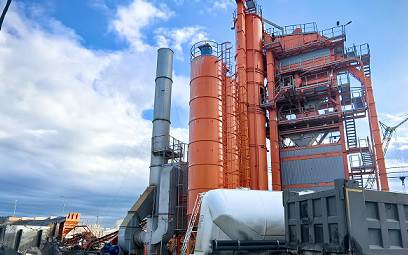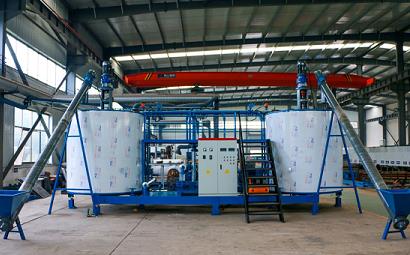Asphalt is a dark-brown complex mixture composed of hydrocarbons of different molecular weights and their non-metallic derivatives. It is a type of high-viscosity organic liquid. It is liquid, has a black surface, and is soluble in carbon disulfide. Uses of asphalt: The main uses are as infrastructure materials, raw materials and fuels. Its application areas include transportation (roads, railways, aviation, etc.), construction, agriculture, water conservancy projects, industry (extracting industry, manufacturing), civil use, etc. department.


Types of asphalt:
1. Coal tar pitch, coal tar pitch is a by-product of coking, that is, the black substance remaining in the distillation kettle after tar distillation. It is only different from refined tar in physical properties, and there is no obvious boundary. The general classification method is to stipulate that those with a softening point below 26.7°C (cubic method) are tar, and those above 26.7°C are asphalt. Coal tar pitch mainly contains refractory anthracene, phenanthrene, pyrene, etc. These substances are toxic, and due to the different contents of these components, the properties of coal tar pitch are also different. Changes in temperature have a great impact on coal tar pitch. It is prone to brittleness in winter and softening in summer. It has a special smell when heated; after 5 hours of heating to 260°C, the anthracene, phenanthrene, pyrene and other components contained in it will volatilize.
2. Petroleum asphalt. Petroleum asphalt is the residue after distillation of crude oil. Depending on the degree of refining, it becomes liquid, semi-solid or solid at room temperature. Petroleum asphalt is black and shiny and has high temperature sensitivity. Since it has been distilled to temperatures above 400°C during the production process, it contains very few volatile components, but there may still be high molecular hydrocarbons that have not been volatilized, and these substances are more or less harmful to human health.
3. Natural asphalt. Natural asphalt is stored underground, and some form mineral deposits or accumulate on the surface of the earth's crust. Most of this asphalt has undergone natural evaporation and oxidation, and generally does not contain any toxins. Asphalt materials are divided into two categories: ground asphalt and tar asphalt. Ground asphalt is divided into natural asphalt and petroleum asphalt. Natural asphalt is the residue after long-term exposure and evaporation of oil seeping out of the ground; petroleum asphalt is the product obtained by treating the residual oil remaining from refined and processed petroleum through appropriate processes. . Tar pitch is a reprocessed product of tar obtained from the carbonization of coal, wood and other organic matter.
The vast majority of asphalt used in engineering is petroleum asphalt, which is a mixture of complex hydrocarbons and their non-metallic derivatives. Usually the flash point of asphalt is between 240℃~330℃, and the ignition point is about 3℃~6℃ higher than the flash point, so the construction temperature should be controlled below the flash point.
 Albanian
Albanian  Russian
Russian  Arabic
Arabic  Amharic
Amharic  Azerbaijani
Azerbaijani  Irish
Irish  Estonian
Estonian  Odia (Oriya)
Odia (Oriya)  Basque
Basque  Belarusian
Belarusian  Bulgarian
Bulgarian  Icelandic
Icelandic  Polish
Polish  Bosnian
Bosnian  Persian
Persian  Afrikaans
Afrikaans  Tatar
Tatar  Danish
Danish  German
German  French
French  Filipino
Filipino  Finnish
Finnish  Frisian
Frisian  Khmer
Khmer  Georgian
Georgian  Gujarati
Gujarati  Kazakh
Kazakh  Haitian Creole
Haitian Creole  Korean
Korean  Hausa
Hausa  Dutch
Dutch  Kyrgyz
Kyrgyz  Galician
Galician  Catalan
Catalan  Czech
Czech  Kannada
Kannada  Corsican
Corsican  Croatian
Croatian  Kurdish (Kurmanji)
Kurdish (Kurmanji)  Latin
Latin  Latvian
Latvian  Lao
Lao  Lithuanian
Lithuanian  Luxembourgish
Luxembourgish  Kinyarwanda
Kinyarwanda  Romanian
Romanian  Malagasy
Malagasy  Maltese
Maltese  Marathi
Marathi  Malayalam
Malayalam  Malay
Malay  Macedonian
Macedonian  Maori
Maori  Mongolian
Mongolian  Bengali
Bengali  Myanmar (Burmese)
Myanmar (Burmese)  Hmong
Hmong  Xhosa
Xhosa  Zulu
Zulu  Nepali
Nepali  Norwegian
Norwegian  Punjabi
Punjabi  Portuguese
Portuguese  Pashto
Pashto  Chichewa
Chichewa  Japanese
Japanese  Swedish
Swedish  Samoan
Samoan  Serbian
Serbian  Sesotho
Sesotho  Sinhala
Sinhala  Esperanto
Esperanto  Slovak
Slovak  Slovenian
Slovenian  Swahili
Swahili  Scots Gaelic
Scots Gaelic  Cebuano
Cebuano  Somali
Somali  Tajik
Tajik  Telugu
Telugu  Tamil
Tamil  Thai
Thai  Turkish
Turkish  Turkmen
Turkmen  Welsh
Welsh  Uyghur
Uyghur  Urdu
Urdu  Ukrainian
Ukrainian  Uzbek
Uzbek  Spanish
Spanish  Hebrew
Hebrew  Greek
Greek  Hawaiian
Hawaiian  Sindhi
Sindhi  Hungarian
Hungarian  Shona
Shona  Armenian
Armenian  Igbo
Igbo  Italian
Italian  Yiddish
Yiddish  Hindi
Hindi  Sundanese
Sundanese  Indonesian
Indonesian  Javanese
Javanese  Yoruba
Yoruba  Vietnamese
Vietnamese  Hebrew
Hebrew  Chinese (Simplified)
Chinese (Simplified)







